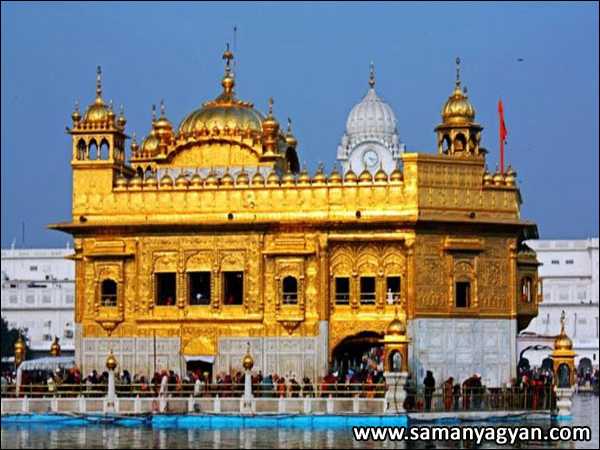Golden Temple Quick Facts
| Place | Amritsar, Punjab (India) |
| Built in | 1581 AD to 1604 AD |
| Built by | Guru Arjun Dev |
| Type | Cultural, Religious Temple |
Golden Temple Overview
India is famous in the world for its various diversities. Many types of religions, cultures and castes are found in India, which have their own special characteristics. The Golden Temple in the city of Amritsar in the Indian state of Punjab is considered the holiest place of pilgrimage for the Sikhs.
Just as Kedarnath, Amarnath, Vaishno Devi for Hindus and Kaaba and Mecca Medina are considered to be the holiest places for Muslims, similarly the Golden Temple has a special significance for the people of Sikhism.
The Golden Temple is considered the holiest site of the Sikhs. It is also known as "Ath Sat Tirath". Arjun Dev Ji, the fifth Guru of the Sikhs, started the construction work of the Golden Temple (Shri Harimandir Sahib) in Amritsar, Punjab.
Golden Temple History
The History of this temple is quite interesting because unity among people of different religions can be seen quite clearly in its history. The idea of building this temple was given by the Fifth Great Sikh Guru, Arjun Dev. Guru Arjun Dev Ji wanted that a temple should be built where Sikhs can come and worship God and serve humanity.
To make this idea a reality, Guru Ramdas Sahib bought land from a zamindar. The foundation of this temple was laid by a Muslim saint, Hazrat Mian Mir Ji and the construction was looked after by Guru Arjun Dev.
The construction of the temple was started in 1581 and was completed by 1604. Guru Granth Sahib was established in this temple by Guru Arjun Dev and Baba Buddha. This temple has been opened for pilgrimage to the Sikh communities.
Some Important Rules of Swarna Mandir:
- To listen to the Guruvani, you must sit on the ground inside the Gurudwara.
- Intoxicants like smoking, drinking, etc. are completely prohibited inside the Gurudwara.
- Before entering the Golden Temple complex, everyone has to take off their shoes.
- Your head should be covered while going inside the Gurudwara. Special clothing or scarves are provided by the temple premises to cover the head. Head covering is a way of showing respect to God.
Golden Temple Interesting Facts
- It took about 20 years to build this temple. Its construction started in December 1581 and it was fully completed by 1604 AD.
- The Golden Temple was destroyed by Ahmed Shah Abdali in 1762, after which it was rebuilt and covered with pure gold by Maharaja Ranjit Singh in 1830.
- The Temple was renovated in 1809 with marble and copper, which was later covered with gold.
- In 1984, some terrorists took control of the Golden Temple, against which the then Indian Prime Minister Indira Gandhi had launched Operation Blue Star, in which a lot of damage was done to the temple and many Sikhs, due to which some angry Sikh bodyguards sent Indira Gandhi to her residence. He was shot outside and killed.
- This Temple also represents the unity of all religions as its foundation was laid by a Muslim saint, Hazrat Mian Mir Ji.
- The Stairs of this temple do not go up like other holy places, but they descend downwards. This entire temple is built far below the level of the city.
- Earlier this temple was also known as Sri Harmandir Sahib and Darbar Sahib which later came to be called Golden Temple due to its gold.
- The Temple can be entered from all four directions indicating that people of different backgrounds are allowed to enter the Gurudwara.
- This Temple is surrounded on all sides by a holy pond called Amrit Sarovar, about which it is believed that bathing in it removes all the sorrows of a person.
- There is also a popular Sikh museum at the center of the Gurdwara, which contains relics and artworks related to Sikhism, its great saints, and warriors.
- The first priest of this famous temple was Shri Baba Budha Ji.
- The kitchen of Golden Temple is the largest kitchen in the world where free food is provided to about 1 lakh devotees every day.
- The beauty and grandeur of the Golden Temple are further enhanced during festivals like Baisakhi, Lohri, Prakashotsav, Martyr's Day, and Sankranti.

